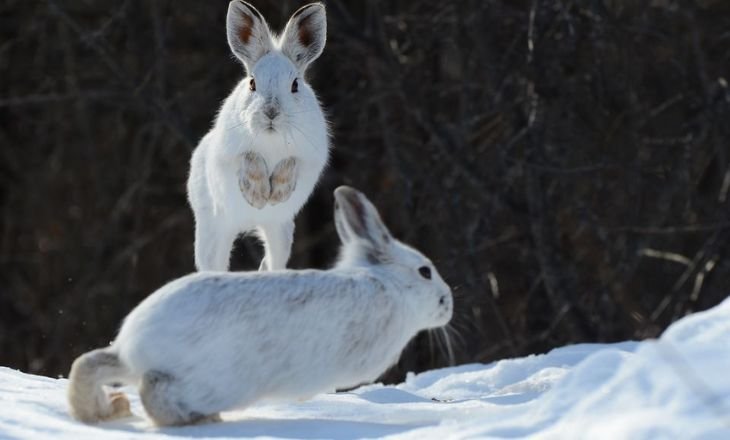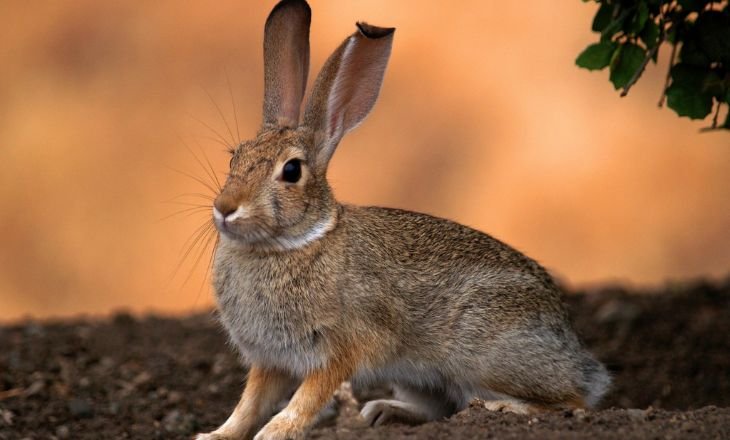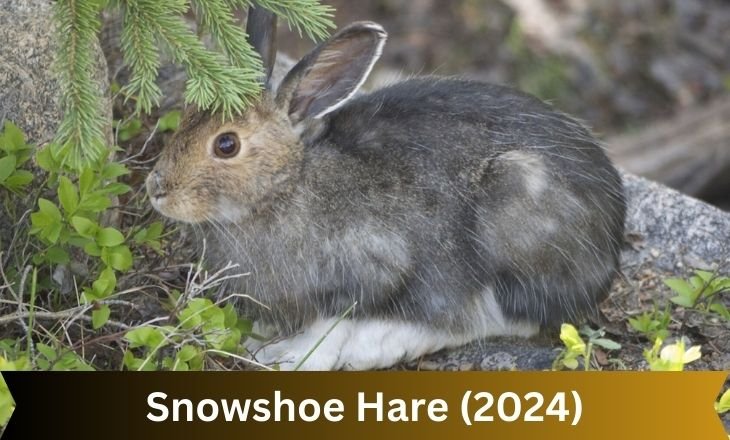In the quiet winter woods of North America, a Snowshoe Hare moves easily through the snow. This hare is well-adapted to survive in tough conditions, blending into its surroundings with its camouflaged fur and large feet.
In 2024, we explore the world of this elusive species and discover its story of resilience, smart ways to avoid predators and its close connection to the changing seasons.
Come with us on a journey through the snowy forests where the mysterious Snowshoe Hare lives, captivating us with its presence among the snow-covered trees and quiet winter atmosphere.
Snowshoe Hare
The hare is a fascinating animal that shows how nature can adapt and change. It has thick fur that changes color with the seasons, helping it blend into its surroundings and hide from predators like lynx and owls.
These hares can switch from brown in summer to white in winter to stay safe. Watching a Hare move quickly through the snow is like seeing a beautiful dance – their quick movements and agility are amazing.
Common Name
The Snowshoe Hare, also known as the Varying Hare, changes its appearance with the seasons. They are skilled at moving through bushes and snow.
Scientific Name
The scientific name for the snowshoe hare is Lepus americanus, reflecting its North American origins and unique characteristics.
Type
Snowshoe are good at adapting to the tough winter areas where they live. One cool thing about them is how they have babies. Female hares have many litters in one breeding season to help their babies survive in the dangerous environment. These tough hares also help keep the forest in balance by eating plants, which is important for the ecosystem.
Diet
The Snowshoe eats a lot mainly grass, clover, and shrubs. They can also eat bark and twigs when there’s not much greenery in winter. This shows how they can adjust to different foods depending on the season. It also shows how tough they are in tough places.
Life Span
Snowshoe Hares live for 1-3 years because of predators and limited food. They are adapted to their environment and have survival strategies. Snowshoe hares have changing population numbers based on food and predators.

Hare Facts
Snowshoe hares have large hind feet that help them move quickly on snow, like snowshoes. Their population goes through cycles, increasing every 8-11 years before decreasing due to factors such as food availability and predators.
Despite these challenges, snowshoe hares survive by reproducing quickly and being active at night. Observing these animals in nature demonstrates their ability to adapt and thrive in their harsh environment.
Hare size
Adult hares are usually 15-20 inches long. They are small but can move fast in their habitats.
Hare Color
The snowshoe changes fur color to survive in winter. In summer, it’s brown, but in winter, it turns white to hide in the snow and avoid predators. Less daylight triggers this change by affecting hormones and activating genes.
Hare Appearance
The snowshoe hare has fur that is brown or gray and blends well. It has big hind feet with thick fur and large toes that work like snowshoes. This helps the hare move through deep snow better than other small animals.
The hare has big eyes and ears for its size, which helps it spot predators and stay alert. Its appearance shows how evolution has made it well-suited for surviving in different habitats. The hare can change color and has a special foot structure, which shows how adaptable and resilient it is in tough environments.
Hare Behavior
Snowshoe can adapt to different environments. They have special camouflage to hide from predators like lynx and birds. Snowshoe hares also change what they eat depending on the season.
Hare Predators
The Canada lynx is a skilled hunter that preys on snowshoe hares by camouflaging in the snow. Not all lynx are successful in catching hares, as hares have ways to evade capture.
Another predator of snowshoe hares is the great horned owl, which hunts at night using its silent flight and keen eyesight to catch hares with its strong talons and accurate strikes.
Hare Reproduction
Snowshoe hares have babies quickly during mating season, which is from February to July. Male hares compete to impress females by chasing and fighting. Once a female chooses a mate, they quickly go through a short courtship before mating.
Female snowshoe hares have a special way of getting pregnant called induced ovulation. They only release eggs after mating to ensure the right conditions for the babies to grow. After about 36 days of being pregnant, female hares give birth to a litter of leverets, which can move around soon after birth.
What Is An Ecological Niche
The snowshoe hare’s role in North American ecosystems is interesting. They eat plants like grasses, ferns, and shrubs. Their population changes because of predators and food. Snowshoe hares have special traits to survive in their changing environment.

Conclusion
The snowshoe Hare is a remarkable species that has adapted to thrive in its snowy habitat. Its unique physical characteristics, behaviour, and ecological role make it a fascinating subject of study for scientists and nature enthusiasts alike.
As we continue to monitor the impacts of climate change on the environment, understanding the resilience of species like the Snowshoe Hare becomes increasingly important. By protecting their habitats and ensuring their survival, we can contribute to the overall health and balance of ecosystems.
Let’s work together to preserve the Snowshoe Hare and other wildlife for future generations to appreciate and enjoy.
Discover the 15 Top Friendliest Dog Breeds of 2024! From loyal Labs to playful Goldens, find your next furry best friend here.
Frequently Asked Question
Do Snowshoe Hares Eat Meat?
No, snowshoe hares are herbivores and primarily feed on plants.
Do Snowshoe Hares Have Teeth?
Yes, snowshoe hares have sharp incisors for chewing vegetation.

